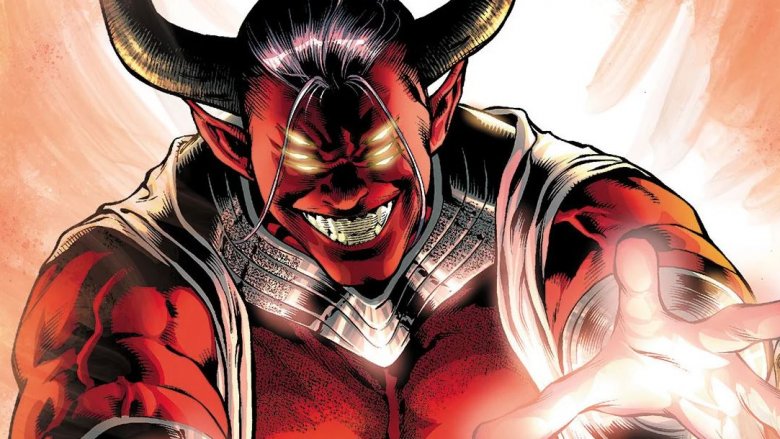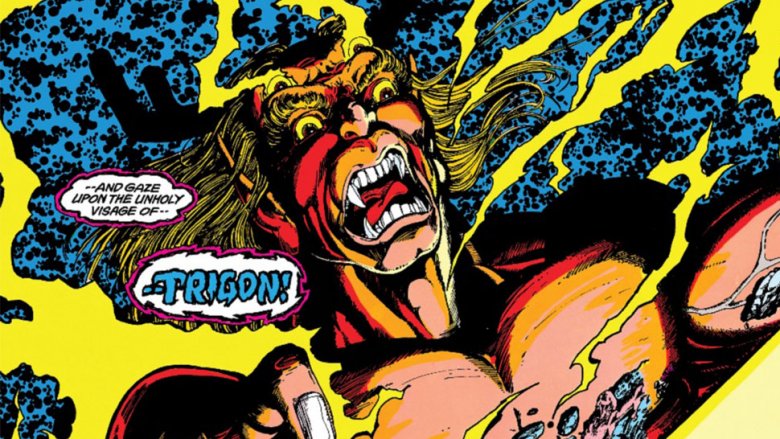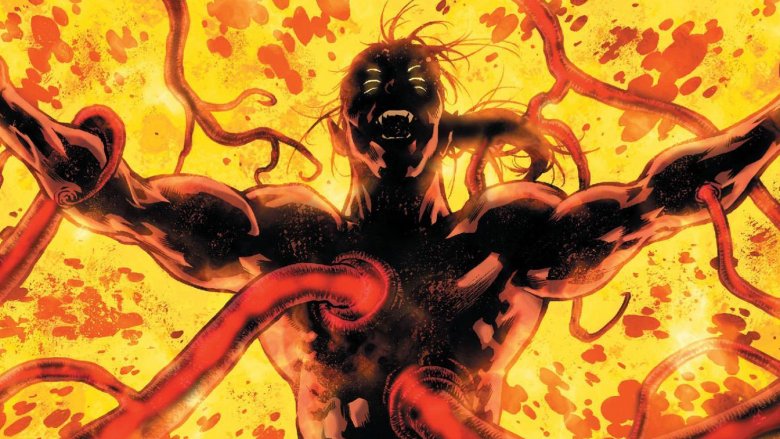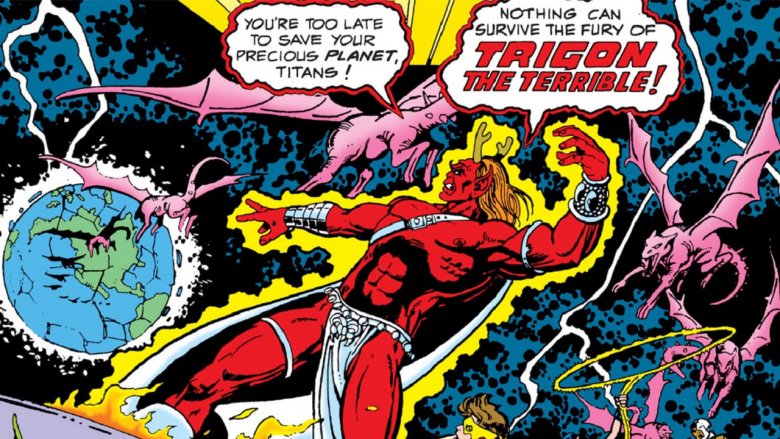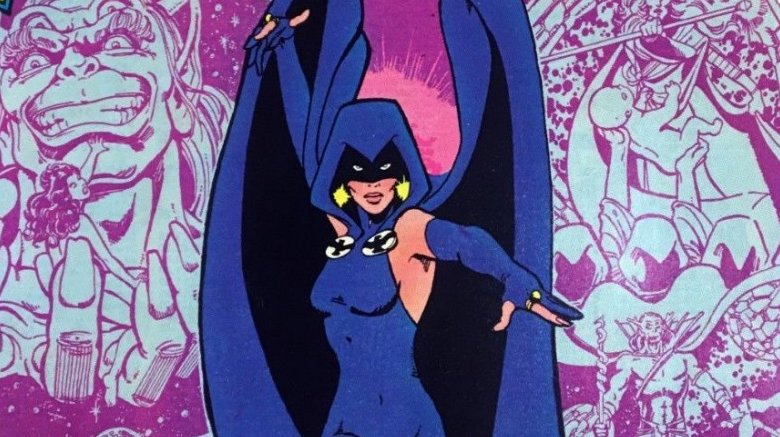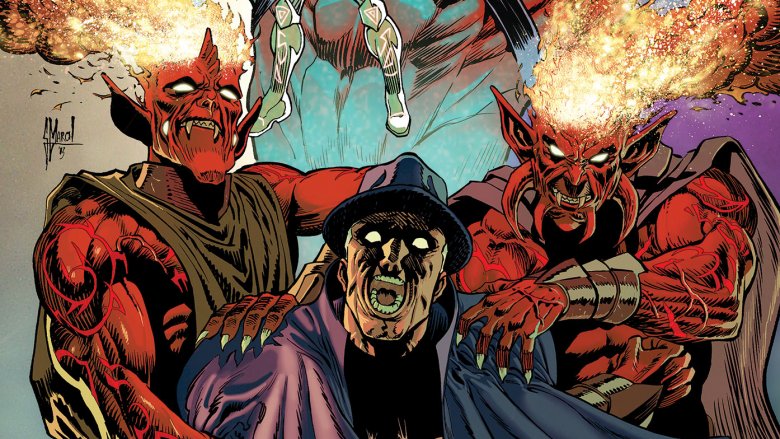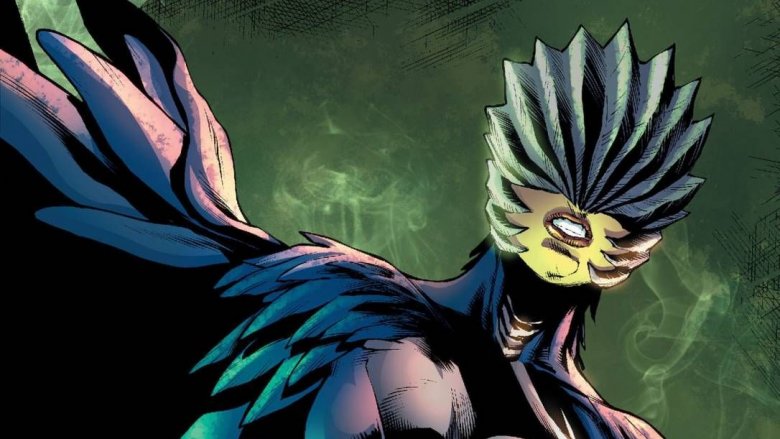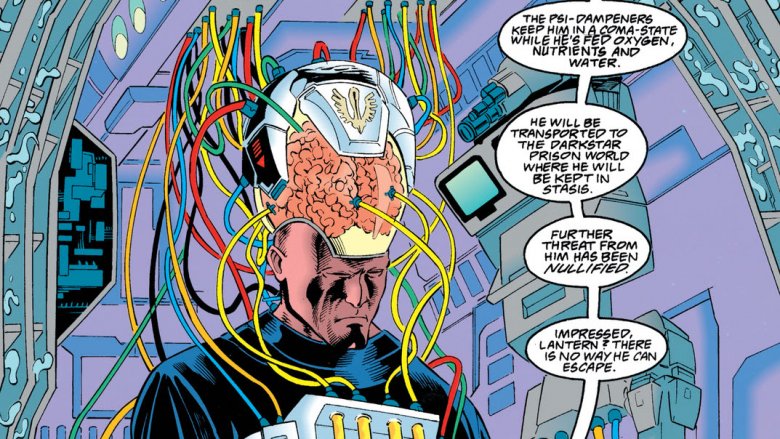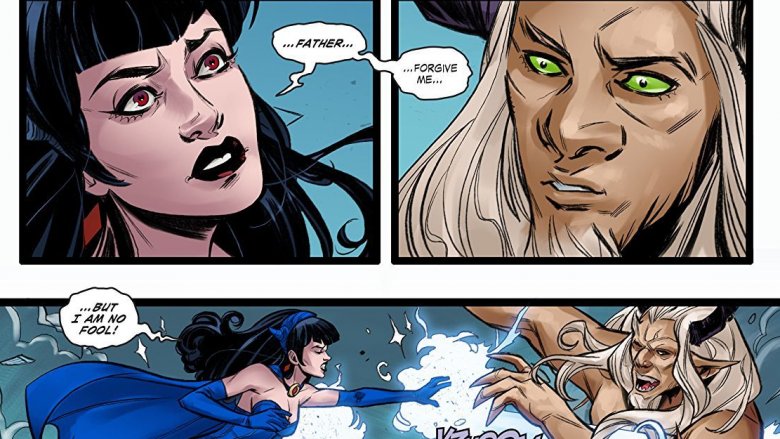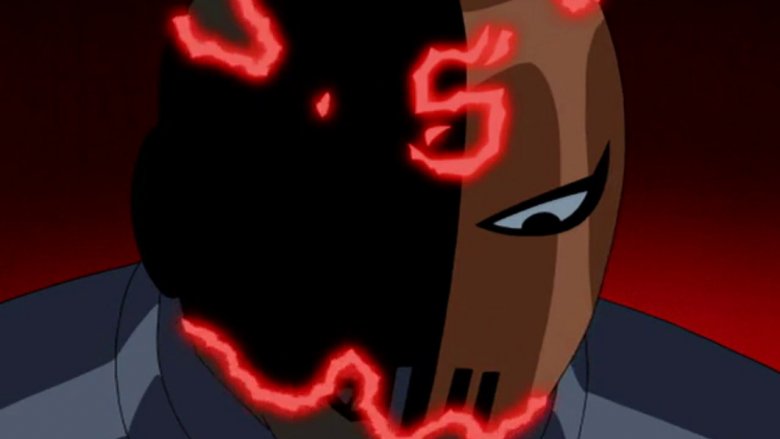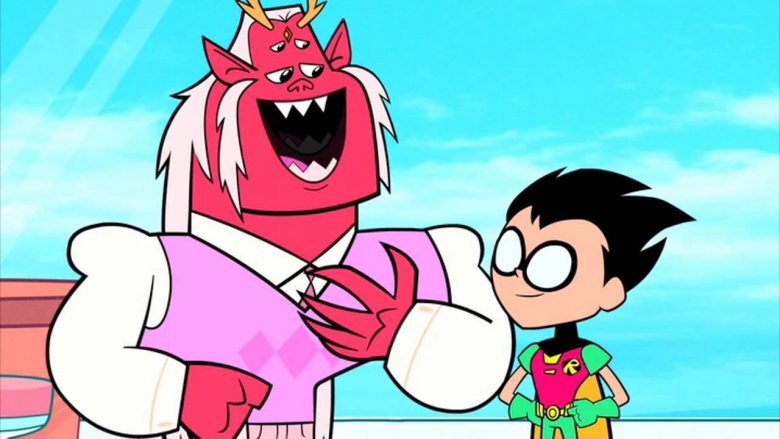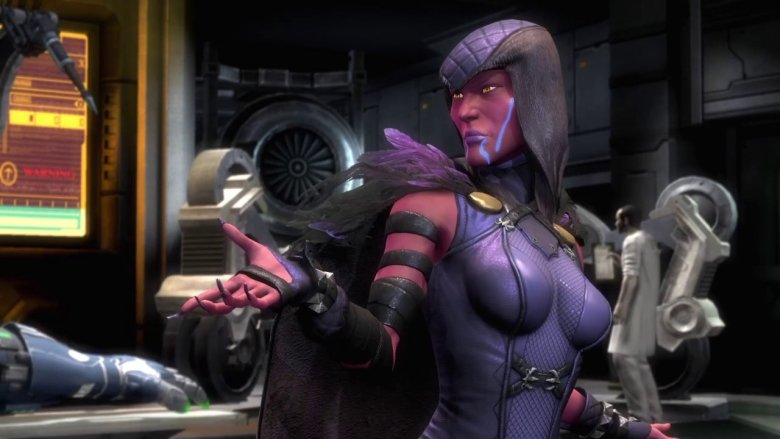The Untold Truth Of Trigon
Trigon the Terrible, scourge of the universe and harasser of Titans, has been one of DC's most fearsome foes for decades. An interdimensional entity, he's basically evil on legs, sporting horns, four eyes, cloven hooves, and a host of powers that range from teleportation to mind control. Trigon's aim — consistent across reboots, rebirths, and retoolings — has always been to dominate everything that can be dominated. There's no planet he won't scorch, no sentient being he won't enslave, no innocent he won't murder to further his villainous reach across the cosmos.
However, in siring his daughter, Raven, he made a fatal mistake. The heroine's heart is good, and she seeks to oppose her father's malicious campaign of death and destruction. Joined by whatever Titans lineup is around, she's often been the reason that Trigon's efforts to conquer the Earth have failed — not that this has stopped him in the long term. When you measure your life in millennia, there's always time to try again.
As one of the Teen Titans' most memorable enemies, Trigon has shown up to menace nearly every incarnation of the team, with the TV show Titans being the most recent entry in that lengthy list. But what makes the demon with the blood red gaze so memorable? Join us as we plumb the depths of Raven's fearsome father and all the havoc he has wreaked.
Trigon is an accident of Azarath
Trigon, avatar of evil and bringer of doom, began as a mistake on the part of the good guys. Centuries ago, a band of humans who were weary of strife created the place that would become Azarath. It was a haven between dimensions, where the streets were marble, the people were kind, and the superheroine known as Raven would eventually grow up. It was paradise, and moreover, one that had been built by human hands. Led by Azar, a visionary mystic who guided the community with grace and conviction, the pacifists of Azarath decided to cement their utopia with a final purging of all evil.
At first, they seemed to have succeeded in this monumental task. The malice lurking in their souls was gathered, lifted, and cast through the Great Door of Azarath, left to dissipate on the cosmic winds. But the dark energy they'd exorcised kept its form, however meager, and began to coalesce into something altogether darker. Aeons passed, until a sect on a doomed and distant planet summoned a dark spirit in a last-ditch attempt at survival. The cast-off energy inhabited a woman of the order, and nine months later, Trigon was born. His first act was to slaughter his mother and her compatriots, which was the beginning of a long and bloody career of conquest.
He's too strong to be contained
Like many comic characters, Trigon doesn't have one singular origin. The "New 52," a line-wide reboot of the DC universe's characters and continuity, gave Trigon an alternate origin rooted in even more potent forms of evil.
According to Teen Titans #23.1, a special issue for DC's Villains Month in which Trigon overtook the team's title, Trigon was created through the folly of a trio of alien beings known as the Divine. Acting as interstellar peacekeepers, they discovered a world they'd thought cleansed of wickedness had devolved into brutal chaos. After finding the man responsible, the Divine attempted to quarantine him by feeding him to the Heart of Darkness, an inescapable abyss to which they consigned all evil. But the culprit was a juvenile Trigon, and his power was too great. Instead of being consumed by the Heart, he consumed it, thus devouring the millions of wicked souls the Divine had placed within it.
Flooded with power, Trigon murdered the Divine and resolved to blanket the universe in his evil. But he quickly found that he couldn't escape a barrier the Divine had erected. Undaunted, he began to transport female humanoids to him, to be impregnated and spread his unholy soul throughout the cosmos. Yeah, it was a different sort of conquest than what he'd imagined, but it was no less terrible or effective.
Trigon is the reason the New Teen Titans were formed
Raven's mother, Arella, fled to Azarath when she realized the truth of her unborn daughter's parentage. Though some on Azarath were wary of Raven, given her demonic ancestry, she was allowed to grow, learn, and master her powers within the sanctity of its borders. But not even an interdimensional Eden could shelter Raven for long, nor keep her ignorant of her father's thirst for power. Terrified of what he might unleash upon an unsuspecting populace, Raven traveled to Earth and asked the Justice League for aid. When she was turned away, she had no choice but to gather a team of heroes on her own who would become the New Teen Titans.
In this way, Trigon sowed the seed of his own destruction. Fear of him didn't keep Raven quiet, pliable, or cowed — it empowered her to do something. She refused to further her father's destructive agenda, refused to accept the Justice League's cold shoulder, and finally, refused to acquiesce to the Armageddon that Trigon, briefly, brought to the Earth. Trigon might've thought siring half-demon children would seal his eventual victory, but he didn't count on their human halves winning out. Raven gained her powers through her pestilent parentage, but it was her ability to love, find fellowship, and work alongside her friends that truly mattered in the fight against her father.
Raven had to die to take him down
When they finally faced off against Trigon, how did the Teen Titans manage to bring down the terror of a thousand worlds? Well, it wasn't easy. An initial attempt — combining all of the Titans' powers, Arella's empathic abilities, and an interdimensional portal — put him away for a while, but it didn't destroy him entirely. Trigon, ever patient, bided his time, ruminating upon the abilities of Raven's new team and how he might counter them, steadily growing in power until he was able to break free of his bonds. In one terrifying campaign of violence, Trigon laid siege to Azarath, murdered its inhabitants, and corrupted Raven's soul entirely.
But the souls of Azarath hadn't dissolved into the ether. Being magically powerful, they dwelt within the Rings of Azar, holy relics worn by Raven. In a complex plan, the Titans were taken over by Trigon's evil and murdered Raven, a terrible act that nevertheless allowed the souls of Azarath to use her as a channel. Trigon was then blasted with pure Azarathian light, and his soul was disincorporated and his body torn apart. Thus vanquished, Raven came back to life, the Titans were freed from Trigon's evil, and the world returned to normal. Good had won ... but not without a battle few of the Titans would ever be able to forget.
Raven isn't his only child
Raven is, of course, Trigon's most famous child. But the legendary baddie made sure to have far more than one kid to choose from when it came to his nefarious plans. Hundreds of Trigon's progeny populate the DC universe, many of them possibly even ignorant of their heritage. Raven wasn't so lucky, and neither were the boys who became known as the Sons of Trigon.
Introduced in 2008's Titans #3, the Sons were originally six in number. Conceived around the same time Raven was, they were intended to embody the seven deadly sins, with Raven as the seventh, representing pride. Jesse, Jared, and Jacob (envy, wrath, and lust, respectively) emerged as the leaders of the heinous septet, and they used Raven as a portal to where their weakened father slumbered. Yet they didn't raise him, as you might expect. Instead, they stole away his power for themselves, an act so evil that it actually made their fearsome father smile.
They were, of course, eventually defeated by Raven and the Titans, but the idea of Raven having siblings was an intriguing enough notion that the New 52 reintroduced it in 2013's The Phantom Stranger #2. Nowadays, Raven has three brothers named Belial, Ruskoff, and Suge. What havoc they might wreak remains to be seen, but the savvy reader can assume it will be terrible when it arrives.
The New 52 saw Trigon grow to respect his daughter
Initially, the New 52 meant a fresh start for Raven as a typical girl named Rachel. But Trigon's daughter never gets a reprieve for long, and the Phantom Stranger ultimately delivered her back into the arms of her father. After a stretch of time in the "under-realms," Raven reemerged as her father's "black bird of terror," keen to conquer the world on his behalf. Trigon had, in fact, discovered a certain respect for his daughter over the course of their time together, naming her as his favorite child and seeking to use her as a spearhead for future attacks on Earth. Naturally, Raven turned against him, saved the world alongside the Titans, and sent Trigon back to whence he came. She hadn't ever truly been his creature. Instead, she'd merely become an impeccable actress.
But Trigon's favoritism was striking during this period, and he even desired to install Raven upon the throne. As Trigon detailed while torturing his other three children, Raven's knowledge of love, compassion, and justice would, he believed, make her a conqueror he himself couldn't become. It's a twisted sort of respect, to be certain, and still largely self-serving. But for a time, Trigon saw his daughter as greater than himself, if only in one crucial aspect.
He's the origin of Psimon's powers
Trigon is an all-star villain, the sort whose appearances require entire storylines' worth of buildup, execution, and denouement. But his evil extends beyond his own stories into others', to the point of creating entirely separate bad guys.
Psimon, an enormously powerful psychic, is the most famous example of Trigon's proteges. Once a physicist seeking to blaze new trials in dimensional exploration, he got quite a bit more than he bargained for when he accidentally breached Trigon's realm. Seizing this rare opportunity, Trigon imbued the hapless scientist with devastating mental abilities and twisted him towards his own desire to conquer the Earth. Psimon set out to further Trigon's mission, joined the Fearsome Five, and began a long and ugly career of brutality, manipulation, and violence.
However, he didn't actually end up doing much to carry out Trigon's plans, and after a stint of banishment, he appeared to have been forgotten by his dark master. But that didn't stop Psimon from using his powers for anything but evil. If anything, he'd been freed to create as much panic and mayhem as he liked, following no agenda but his own desire to inflict cruelty. Psimon stands as a monument to Trigon's malice and power, a decent enough member of society left shattered and rotten by a passing glance from worlds-shaking evil.
Das Trigon of the Alps
One of the best things about superhero comics is their multiple-choice approach to storytelling. Take Batman, for example. He's got dead parents, a mansion on a hill, a cave full of doodads, and a butler to patch him up after a long night of crime-fighting. But there are dozens of other takes on the Caped Crusader, from the Victorian environs of Gotham by Gaslight to Batman Beyond's futuristic vision of a Gotham where Bruce Wayne is an elderly mentor. Somehow, he's a character everyone recognizes, yet he's also one open to endless reinterpretation.
So it goes with Trigon. Perhaps his most unique form is that of "Das Trigon," a villain of the DC Bombshells series. Within the Bombshells universe, Trigon was a German mountain spirit whose liaison with a human woman led to Raven. Here, Raven grew up in a small Alpine village, instructed by her grandfather in the control of her powers until the Joker's daughter upended her tranquil life. Eventually, Raven rediscovered her father working for dark masters, but this wasn't the aimless evil of Trigon's past. In this story, Trigon felt utterly untethered when Raven's mother died, so he gave up on goodness to join the dastardly General Faora ... until Faora threatened Raven's life.
Trigon fell defending his daughter, who buried him beneath a tree and wept for the father she'd never known as well as she would've liked. It was a very different Trigon, indeed, and all the more affecting for it.
Deathstroke, the unlikely servant
Trigon has rarely worked alone, having relied on an army of minions, henchmen, and cultists to support and carry out his terrifying whims for untold millennia. But the 2003 animated Teen Titans series saw him employ a person he'd never worked with before: Deathstroke the Terminator, known in the series as Slade, DC's most infamous and effective killer-for-hire.
It began with the show's adaptation of "The Judas Contract," one of the New Teen Titans' most celebrated story arcs. Through the animated Terra did betray the Titans to Slade, as she did in the comics, she redeemed herself in her last moments by reneging on the deal, getting the Titans to safety and uppercutting Slade into a pit of lava. There he died, but on the way to whatever afterlife he'd been speeding towards, he was intercepted by Trigon, wielding a deal. If Slade promised to work for him, he'd give him back his life. Slade agreed and spent the fourth season the series acting as Trigon's herald, servant, and messenger.
Once Trigon made his way to the Earth, however, he backed out of the deal, forcing Slade to work alongside the Titans. Eventually, the day was saved. Slade got his body back, the apocalypse was soundly reversed, and Raven obliterated Trigon in a dazzling blaze of power. But for a time, however unlikely, the dedicated mercenary worked for DC's most dastardly demon in an unstoppable team-up of seething evil and tactical genius.
Sweater vests and prom invites
Children today can't get enough of Teen Titans Go!, a frenetic series where Robin, Starfire, Beast Boy, Raven, and Cyborg spend more time scarfing burritos and getting into wacky scrapes involving waffles than they do crime-fighting. For as off-the-wall as the cartoon is, however, it digs deeply into DC's vast and complex history — including, of course, Trigon and all the terror he's visited upon the Titans.
But like so many classic characters who've made an appearance on Teen Titans Go!, this cartoon version of Trigon is ... rather different. Instead of his usual look — antlers, capes, ragged loincloths — he wears sweater vests, slacks, and neckties. And sure, yes, he's described as the "master of the dark, destroyer of dimensions, enslaver of civilization," but, well, he does make sure to always spend Thanksgiving with his daughter. And when Demon Prom rolls around, he nominates Raven for Prom Queen. And he does spend Fathers' Day leafing through treasured photos of his baby girl. Trigon is a bad guy in Teen Titans Go!, but that doesn't necessarily mean he's a bad dad. He might want to rule the Earth, but he also wants what's best for his precious daughter, no matter how embarrassed that might make her.
Trigon's obedient daughter (in one continuity)
Raven's constant over the course of her many reinventions, reimaginings, and retool attempts is her defiance of her father. Whether she's refusing to go to Demon Prom or take over the world, she and Trigon stand apart, opposed, and ultimately, at each other's throats. But there's one universe in which that isn't the case, where, in fact, Raven is Trigon's gleeful minion. This is the universe of Injustice: Gods Among Us, a fighting game series that begat a sprawling fictional saga all its own.
The world of Injustice is bleak, featuring a totalitarian Superman driven to dictatorial madness by the nuclear destruction of Metropolis at the hands of the Joker. Though the Raven of this world once resisted her father, the trauma of losing loved ones sent her spiraling into her darkest impulses, and thus, into her father's embrace. When Raven first shows up, she's a happy minion of Superman's regime and actively planning her father's upcoming invasion. Though it's only in this iteration of the DC universe that Trigon commands a willing daughter, it's a chilling vision indeed.
